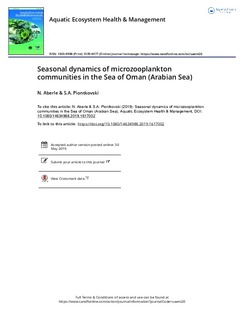| dc.contributor.author | Aberle-Malzahn, Nicole | |
| dc.contributor.author | Piontkovski, SA | |
| dc.date.accessioned | 2020-01-30T09:39:29Z | |
| dc.date.available | 2020-01-30T09:39:29Z | |
| dc.date.created | 2019-10-28T21:48:47Z | |
| dc.date.issued | 2019 | |
| dc.identifier.citation | Aquatic Ecosystem Health & Management. 2019, 22 (2), 131-140. | nb_NO |
| dc.identifier.issn | 1463-4988 | |
| dc.identifier.uri | http://hdl.handle.net/11250/2638804 | |
| dc.description.abstract | Seasonal dynamics of microzooplankton and changes in environmental condition were analysed during a one-year field sampling campaign in the Sea of Oman at two different stations. Monsoon winds in this region cause distinct seasonality patterns with high primary productivity during the south-west monsoon in summer (June to October) and north-east monsoon periods in winter (November to March). Microzooplankton in the Sea of Oman showed several biomass peaks throughout the year. In general, higher biomass occurred during the south-west monsoon when compared to the north-east monsoon period with maxima of 190 µg C l−1at the inshore station Bandar Al-Khyran at 1m and 308 µg C l−1 at 10m water depth. At the offshore-station, peaks of 372 µg C l−1 (1m) and 256 µg C l−1 (20m) occurred during the south-west monsoon. A strong coupling between phytoplankton and microzooplankton was observed during monsoon periods but some microzooplankton peaked during inter-monsoon periods when chlorophyll concentration was low (Bandar Al-Khyran: 372 µg C l−1 at 1m and 196 µg C l−1, 10m; Offshore-station: 419 µg C l−1, 20 m). The initiation of phytoplankton blooms in the Sea of Oman was bottom-up controlled due to strong seasonal nutrient influx during south-west and north-east monsoon periods. Highest microzooplankton biomass occurred during monsoon periods with a dominance of Noctiluciphyceae and peaks of 7596 µg C l−1 at Bandar Al-Khyran (1m) and 5942 µg C l−1 (10m). Copepod nauplii, Amoebozoa and Larvacea contributed substantially to microzooplankton biomass throughout the year. Ciliophora contributed low proportion to the total microzooplankton biomass peaking both during monsoon and inter-monsoon periods. During the spring inter-monsoon, choreotrich ciliates (tintinnids) showed distinct peaks of 15.9 µg C l−1 at Bandar Al-Khyran (1m) and 17.7 µg C l−1 (10m) as well as 18.2 µg C l−1 at Offshore-station (20m). The interplay between bottom-up controlled primary production and top-down control mechanisms regulates the phenology patterns of specific microzooplankton groups in the Sea of Oman thus pointing at complex trophodynamic interactions at the lowermost foodweb level in this low-latitude ecosystem. | nb_NO |
| dc.language.iso | eng | nb_NO |
| dc.publisher | Taylor & Francis | nb_NO |
| dc.title | Seasonal dynamics of microzooplankton communities in the Sea of Oman (Arabian Sea) | nb_NO |
| dc.type | Journal article | nb_NO |
| dc.type | Peer reviewed | nb_NO |
| dc.description.version | acceptedVersion | nb_NO |
| dc.source.pagenumber | 131-140 | nb_NO |
| dc.source.volume | 22 | nb_NO |
| dc.source.journal | Aquatic Ecosystem Health & Management | nb_NO |
| dc.source.issue | 2 | nb_NO |
| dc.identifier.doi | 10.1080/14634988.2019.1617002 | |
| dc.identifier.cristin | 1741431 | |
| dc.description.localcode | Locked until 26.8.2020 due to copyright restrictions. This is an [Accepted Manuscript] of an article published by Taylor & Francis, available at https://doi.org/10.1080/14634988.2019.1617002 | nb_NO |
| cristin.unitcode | 194,66,10,0 | |
| cristin.unitname | Institutt for biologi | |
| cristin.ispublished | true | |
| cristin.fulltext | postprint | |
| cristin.qualitycode | 1 | |
